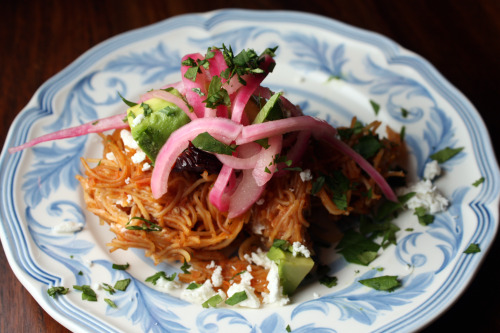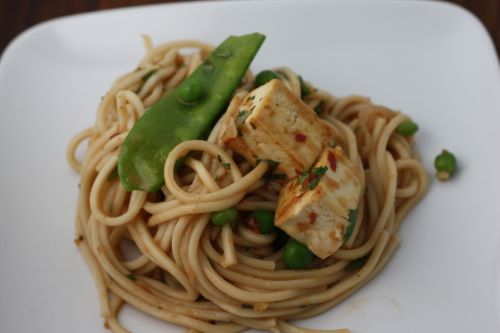Some days I have a story and some days I just need to tell you about a dish that is super yummy and maybe a little unusual. This is one of those days.
I am no expert but from what I can gather, fideo is the Spanish word for noodle. In this dish, very thin noodles are sautéed in oil until they brown, then a smoky tomato sauce is poured over top. The noodles then cook in the sauce until soft and until they brown on the bottom. Throw some pasilla chiles in the mix and top the whole thing with sour cream, avocado, and pickled onions and you will probably just want to call it “yum”.
The recipe suggests making this in a cast iron skillet or a non-stick pan. My cast iron skillet was too big for this job and my non-stick pan was too small. I made it in a Le Crueset dutch oven, but I had to mix it more than I wanted to so that it wouldn’t stick until the end of time. Next time, I am going to double it and just make it in my cast iron skillet (and improvise some kind of lid) because my husband could probably eat ¾ of the dish by himself and I want me some of that crust. And leftovers would certainly be nice.
One Year Ago: Mediterranean Roasted Vegetable Salad
Fideos with Pasilla Chiles, Avocado, and Crema
Adapted from Vegetarian Suppers from Deborah Madison’s Kitchen
Serves 3-4
The chiles will make this dish delightfully spicy – just a warning. The original recipe calls for parsley instead of cilantro so feel free to use that if you don’t like cilantro.
3 dried pasilla, New Mexican, or guajillo chiles
4 plump garlic cloves, unpeeled
3 tbsp. canola oil
1 15-oz. can Muir Glen Fire Roasted tomatoes
Kosher salt and freshly ground black pepper
1 large shallot, coarsely chopped
½ pound short, skinny egg noodles (like spaghetti or noodle nests)
3 cilantro sprigs, plus ½ a cup chopped cilantro leaves
½ cup Mexican crema, crème fraîche, or sour cream
3 ounces feta cheese or queso fresco
1 avocado, peeled and sliced, for garnish
Pickled onions for garnish (recipe follows)
1. Cover the dried chiles with hot water and set them aside to soften while you make the tomato sauce. When soft, tear or cut the flesh into strips. Discard the seeds.
2. Moisten the unpeeled garlic cloves with a little of the oil, then cook them in a small skillet over medium-low heat, occasionally sliding the cloves around the pan, until the skins are toasted and the cloves are soft, 10 to 15 minutes. Allow to cool, then squeeze the garlic from the skins into a blender and add the canned tomatoes, 1 teaspoon of salt, the shallot and ½ cup of water. Purée.
3. Heat the remaining oil in a cast iron skillet or non-stick pan over medium-high heat. Break the noodles into pieces about 1½ inches in length. Add the noodles to the oil and stir them around until they’re lightly browned, then add the tomato sauce and cilantro sprigs. Add all but a few of the torn chiles, then even out the contents, and adjust the heat to a simmer. Cover the pan and cook until the noodles are soft, 15 minutes or so. Season with pepper.
4. Loosen the cream with a fork, then drizzle it over the surface of the finished dish. Crumble the cheese over the cream, scatter on the remaining chile pieces, and slice the avocado all over. Add a little chopped cilantro and some pickled onions and serve, being sure to scrap up all that delectable crust that lurks on the bottom of the pan.
Pickled Onions
1 small red onion, thinly sliced into rounds
Sea salt
1 tsp. sugar
Apple cider vinegar or rice wine vinegar
Toss the onion rounds with a pinch of salt and the sugar. Put them in a bow with vinegar to cover; they’ll turn bright pink in about 15 minutes. They will keep for about 5 days in the refrigerator.



 Share
Share
